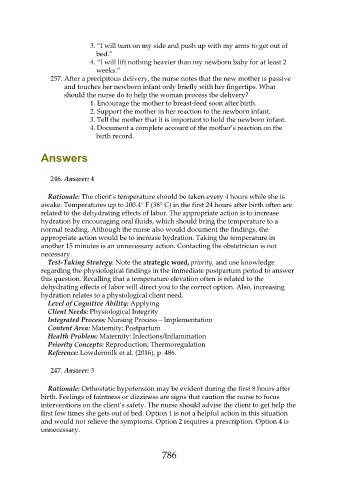Page 786 - Saunders Comprehensive Review For NCLEX-RN
P. 786
3. “I will turn on my side and push up with my arms to get out of
bed.”
4. “I will lift nothing heavier than my newborn baby for at least 2
weeks.”
257. After a precipitous delivery, the nurse notes that the new mother is passive
and touches her newborn infant only briefly with her fingertips. What
should the nurse do to help the woman process the delivery?
1. Encourage the mother to breast-feed soon after birth.
2. Support the mother in her reaction to the newborn infant.
3. Tell the mother that it is important to hold the newborn infant.
4. Document a complete account of the mother’s reaction on the
birth record.
Answers
246. Answer: 4
Rationale: The client’s temperature should be taken every 4 hours while she is
awake. Temperatures up to 100.4° F (38° C) in the first 24 hours after birth often are
related to the dehydrating effects of labor. The appropriate action is to increase
hydration by encouraging oral fluids, which should bring the temperature to a
normal reading. Although the nurse also would document the findings, the
appropriate action would be to increase hydration. Taking the temperature in
another 15 minutes is an unnecessary action. Contacting the obstetrician is not
necessary.
Test-Taking Strategy: Note the strategic word, priority, and use knowledge
regarding the physiological findings in the immediate postpartum period to answer
this question. Recalling that a temperature elevation often is related to the
dehydrating effects of labor will direct you to the correct option. Also, increasing
hydration relates to a physiological client need.
Level of Cognitive Ability: Applying
Client Needs: Physiological Integrity
Integrated Process: Nursing Process—Implementation
Content Area: Maternity: Postpartum
Health Problem: Maternity: Infections/Inflammation
Priority Concepts: Reproduction; Thermoregulation
Reference: Lowdermilk et al. (2016), p. 486.
247. Answer: 3
Rationale: Orthostatic hypotension may be evident during the first 8 hours after
birth. Feelings of faintness or dizziness are signs that caution the nurse to focus
interventions on the client’s safety. The nurse should advise the client to get help the
first few times she gets out of bed. Option 1 is not a helpful action in this situation
and would not relieve the symptoms. Option 2 requires a prescription. Option 4 is
unnecessary.
786

